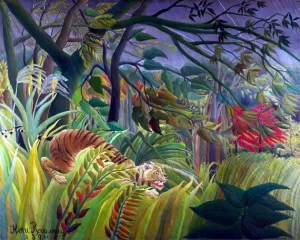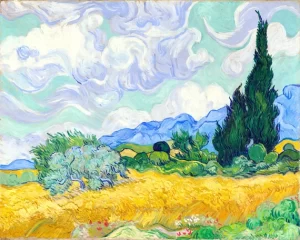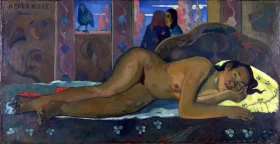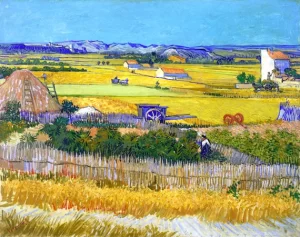5% Off Sitewide | Use code KMUS5 on checkout
- Choose your Country
5% Off Sitewide | Use code KMUS5 on checkout
Post-Impressionism
Post-Impressionism is the term coined by the British artist and art critic Roger Fry in 1910 to describe the development of French art since Manet.
Post-Impressionists extended Impressionism while rejecting its limitations: they continued using vivid colours, thick application of paint, distinctive brushstrokes and real-life subject matter, but they were more inclined to emphasize geometric forms, to distort form for expressive effect, and to use unnatural or arbitrary colour.
The Post Impressionists were dissatisfied with the triviality of subject matter and the loss of structure in Impressionist paintings, though they did not agree on the way forward. Georges Seurat and his followers concerned themselves with Pointillism, the systematic use of tiny dots of colour. Paul Cezanne set out to restore a sense of order and structure to painting, to “make of Impressionism something solid and durable, like the art of the museums”. He achieved this by reducing objects to their basic shapes while retaining the bright fresh colours of Impressionism. The Impressionist Camille Pissarro experimented with Neo-Impressionist ideas between the mid 1880s and the early 1890s. Discontented with what he referred to as romantic Impressionism, he investigated Pointillism which he called scientific Impressionism before returning to a purer Impressionism in the last decade of his life. Vincent van Gogh used colour and vibrant swirling brush strokes to convey his feelings and his state of mind. Although they often exhibited together, Post-Impressionist artists were not in agreement concerning a cohesive movement. Younger painters during the 1890s and early 20th century worked in geographically disparate regions and in various stylistic categories, such as Fauvism and Cubism.
The term was coined in 1910 by Roger Fry in the title of an exhibition of modern French painters, organized by Fry in London. Most of the artists in the exhibition were younger than the Impressionists. Fry later explained: “For purposes of convenience, it was necessary to give these artists a name, and I chose, as being the vaguest and most non-committal, the name of Post-Impressionism. This merely stated their position in time relatively to the Impressionist movement.” John Rewald, one of the first professional art historians to focus on the birth of early modern art, limited the scope to the years between 1886 and 1892 in his pioneering publication on Post-Impressionism: From Van Gogh to Gauguin (1956): Rewald considered it to continue his History of Impressionism (1946), and pointed out that a “subsequent volume dedicated to the second half of the post-impressionist period”-Post-Impressionism: From Gauguin to Matisse-was to follow, extending the period covered to other artistic movements derived from Impressionism and confined to the late 19th and early 20th centuries. Rewald focused on outstanding early Post-Impressionists active in France: on Van Gogh, Gauguin, Seurat, Redon, and their relations as well as the artistic circles they frequented (or they were in opposition to):
* Neo-Impressionism: ridiculed by contemporary art critics as well as artists as Pointillism, Seurat and Signac would have preferred other terms: Divisionism for example.
* Cloisonnism: a short-lived term introduced in 1888 by the art critic Edouard Dujardin, was to promote the work of Louis Anquetin, and was later also applied to contemporary works of his friend emile Bernard.
* Synthetism: another short-lived term coined in 1889 to distinguish recent works of Gauguin and Bernard from that of more traditional Impressionists exhibiting with them at the Cafe Volpini.
* Pont-Aven School: implying little more than that the artists involved had been working for a while in Pont-Aven or elsewhere in Brittany.
* Symbolism: a term highly welcomed by vanguard critics in 1891, when Gauguin dropped Synthetism as soon as he was acclaimed to be the leader of Symbolism in painting.
Furthermore, in his introduction to Post-Impressionism, Rewald opted for a second volume featuring Toulouse-Lautrec, Henri Rousseau “le Douanier”, Les Nabis and Cezanne as well as the Fauves, the young Picasso and Gauguin’s last trip to the South-Sea, it was to expand the period covered at least into the first decade of the 20th century-yet this second volume remained unfinished.In a basic sense, the term “Romanticism” has been used to refer to certain artists, poets, writers, musicians, as well as political, philosophical and social thinkers of the late 18th and early to mid 19th centuries. It has equally been used to refer to various artistic, intellectual, and social trends of that era. Despite this general usage of the term, a precise characterization and specific definition of Romanticism have been the subject of debate in the fields of intellectual history and literary history throughout the twentieth century, without any great measure of consensus emerging. Arthur Lovejoy attempted to demonstrate the difficulty of this problem in his seminal article “On The Discrimination of Romanticisms” in his Essays in the History of Ideas (1948), some scholars see Romanticism as essentially continuous with the present, some see in it the inaugural moment of modernity, some see it as the beginning of a tradition of resistance to the Enlightenment-a Counter-Enlightenment-and still others place it firmly in the direct aftermath of the French Revolution. An earlier definition comes from Charles Baudelaire: “Romanticism is precisely situated neither in choice of subject nor exact truth, but in the way of feeling.”
Reviews and adjustments
Rewald wrote that “the term ‘Post-Impressionism’ is not a very precise one, though a very convenient one.” Convenient, when the term is by definition limited to French visual arts derived from Impressionism since 1886. Rewald’s approach to historical data was narrative rather than analytic, and beyond this point he believed it would be sufficient to “let the sources speak for themselves.”
Rival terms like Modernism or Symbolism were never as easy to handle, for they covered literature, architecture and other arts as well, and they expanded to other countries.
* Modernism thus, is now considered to be the central movement within international western civilization with its original roots in France, going back beyond the French Revolution to the Age of Enlightenment.
* Symbolism, however, is considered to be a concept which emerged a century later in France, and implied an individual approach. Local national traditions as well as individual settings therefore could stand side by side, and from the very beginning a broad variety of artists practising some kind of symbolic imagery, ranged between extreme positions: The Nabis for example united to find synthesis of tradition and brand new form, while others kept to traditional, more or less academic forms, when they were looking for fresh contents: Symbolism is therefore often linked to fanatastic, esoteric, erotic and other non-realist subject matter.
To meet the recent discussion, the connotations of the term ‘Post-Impressionism’ were challenged again: Alan Bowness and his collaborators expanded the period covered to 1914, but limited their approach widely on the 1890s to France. Other European countries are pushed back to standard connotations, and Eastern Europe is completely excluded.
So, while a split may be seen between classical ‘Impressionism’ and ‘Post-Impressionism’ in 1886, the end and the extend of ‘Post-Impressionism’ remains under discussion. For Bowness and his contributors as well as for Rewald, ‘Cubism’ was an absolutely fresh start, and so Cubism has been seen in France since the beginning, and later in Anglosaxonia. Meanwhile Eastern European artists, however, did not care so much for western traditions, and proceeded to manners of painting called abstract and suprematic-terms expanding far into the 20th century.
Conclusion
According to the present state of discussion, Post-Impressionism is a term best used within Rewald’s definition in a strictly historical manner, concentrating on French art between 1886 and 1914, and re-considering the altered positions of impressionist painters like Claude Monet, Camille Pissarro, Auguste Renoir, and others-as well as all new brands at the turn of the century: from Cloisonnism to Cubism. The declarations of war, in July/August 1914, indicate probably far more than the beginning of a World War-they signal a major break in European cultural history, too.
Showing 1–100 of 2161 results

A Sunday On La Grande Jatte 1884
By Georges SeuratSizes starting at $299.00
Surprised
By Henri RousseauSizes starting at $279.00
Terrace Of A Café At Night (Place Du Forum) 1888
By Vincent Van GoghSizes starting at $259.00
The Bridge of Boieldieu and the Orleans Station Rouen Sunny Day 1898
By Camille PissarroSizes starting at $279.00
The Large Bathers 1906
By Paul CezanneSizes starting at $319.00
Where Do We Come From? Who are We? Where are We Going?
By Paul GauguinSizes starting at $539.00
Bathers At Asnières
By Georges SeuratSizes starting at $309.00
Le Boulevard Montmartre, MatinéE de Printemps 1897
By Camille PissarroSizes starting at $259.00
Spirit of the Dead Watching
By Paul GauguinSizes starting at $299.00
The Card Players
By Paul CezanneSizes starting at $309.00
The Sleeping Gypsy
By Henri RousseauSizes starting at $299.00
The Starry Night Saint Remy
By Vincent Van GoghSizes starting at $279.00
Jug, Curtain and Fruit Bowl
By Paul CezanneSizes starting at $259.00
Red Roofs, Corner of a Village, Winter 1877
By Camille PissarroSizes starting at $259.00
Starry Night Over The Rhone
By Vincent Van GoghSizes starting at $269.00
The Channel Of Gravelines, Petit Fort Philippe
By Georges SeuratSizes starting at $279.00
The Dream (Le Rêve)
By Henri RousseauSizes starting at $289.00
The Yellow Christ
By Paul GauguinSizes starting at $279.00
Country Road In Provence By Night 1890
By Vincent Van GoghSizes starting at $259.00
Entrance Of The Port Of Honfleur
By Georges SeuratSizes starting at $269.00
Landscape With Farmhouses and Palm Trees 1856
By Camille PissarroSizes starting at $289.00
Mont Sainte-Victoire and the Viaduct of the Arc River Valley
By Paul CezanneSizes starting at $279.00
Nafea Faaipoipo (When are you Getting Married?)
By Paul GauguinSizes starting at $329.00
Two lions on the lookout in the jungle
By Henri RousseauSizes starting at $279.00
A Wheatfield With Cypress 1889
By Vincent Van GoghSizes starting at $279.00
La RéColte des Foins, ÉRagny 1887
By Camille PissarroSizes starting at $269.00
Nevermore O TaïTi
By Paul GauguinSizes starting at $389.00
Pyramid of Skulls 1901
By Paul CezanneSizes starting at $269.00
The Canal Of Gravelines, In The Direction Of The Sea
By Georges SeuratSizes starting at $289.00
The Snake Charmer
By Henri RousseauSizes starting at $259.00
Green Wheat Field With Cypress (1889)
By Vincent Van GoghSizes starting at $259.00
Jalais Hill, Pontoise 1867
By Camille PissarroSizes starting at $289.00
The Basket of Apples 1893
By Paul CezanneSizes starting at $279.00
The Canal Of Gravelines, In The Direction Of The Sea
By Georges SeuratSizes starting at $259.00
The-Ship-in-the-Tempest
By Henri RousseauSizes starting at $269.00
Two Tahitian Women with Mango Flowers
By Paul GauguinSizes starting at $289.00
Myself, Landscape Portrait
By Henri RousseauSizes starting at $269.00
Port-En-Bessin, Entrance To The Harbor 1888
By Georges SeuratSizes starting at $269.00
Portrait of Madame Cézanne
By Paul CezanneSizes starting at $309.00
Vision of the Sermon (Jacob Wrestling with the Angel)
By Paul GauguinSizes starting at $299.00
Wheat Field With Cypresses 1889
By Vincent Van GoghSizes starting at $279.00
White Frost 1873
By Camille PissarroSizes starting at $279.00
Field With Irises Near Arles
By Vincent Van GoghSizes starting at $269.00
Foreign Powers Coming to Greet the Republic as a Sign of Peace
By Henri RousseauSizes starting at $279.00
Harbour Entrance At Honfleur, 1886
By Georges SeuratSizes starting at $269.00
L’estaque, Melting Snow
By Paul CezanneSizes starting at $269.00
The Crystal Palace 1871
By Camille PissarroSizes starting at $299.00
Vincent Van Gogh Painting Sunflowers
By Paul GauguinSizes starting at $299.00
Ia Orana Maria (Hail Mary)
By Paul GauguinSizes starting at $289.00
La Rade De Grandcamp (Le Port De Grandcamp)
By Georges SeuratSizes starting at $279.00
Les Quatre Saisons-L’Eté 1872
By Camille PissarroSizes starting at $399.00
The Boy in the Red Vest
By Paul CezanneSizes starting at $309.00
The Equatorial Jungle
By Henri RousseauSizes starting at $239.00
The Harvest With Blue Cart 1888
By Vincent Van GoghSizes starting at $279.00
Exotic Landscape
By Henri RousseauSizes starting at $269.00
Green Wheat Fields, Auvers 1890
By Vincent Van GoghSizes starting at $269.00
Les Quatre Saisons-Le Printemps 1872
By Camille PissarroSizes starting at $409.00
Parau Api. What News
By Paul GauguinSizes starting at $329.00
The Channel At Gravelines, Evening
By Georges SeuratSizes starting at $259.00
The Murder 1870
By Paul CezanneSizes starting at $259.00
Harbour At Port-En-Bessin At High Tide
By Georges SeuratSizes starting at $259.00
Les Quatre Saisons-L’Automne 1872
By Camille PissarroSizes starting at $409.00
Monkeys and Parrot in the Virgin Forest
By Henri RousseauSizes starting at $249.00
Tahitian Woman with a Flower
By Paul GauguinSizes starting at $309.00
The Card Players (Les Joueurs De Cartes)
By Paul CezanneSizes starting at $399.00
The Sower (Sower At Sunset) 1888
By Vincent Van GoghSizes starting at $279.00
Les Quatre Saisons-L’Hiver 1872
By Camille PissarroSizes starting at $409.00
Port-En-Bessin
By Georges SeuratSizes starting at $259.00
Tahitian Women on the Beach
By Paul GauguinSizes starting at $339.00
The Card Players
By Paul CezanneSizes starting at $379.00
The Merry Jesters
By Henri RousseauSizes starting at $269.00
Wheat Field With Reaper, Auvers 1890
By Vincent Van GoghSizes starting at $279.00
Apple-Harvest-1888
By Camille PissarroSizes starting at $259.00
Fight-between-a-Tiger-and-a-Buffalo,-1908
By Henri RousseauSizes starting at $249.00
Grand Fort-Philippe
By Georges SeuratSizes starting at $279.00
Les Vessenots In Auvers
By Vincent Van GoghSizes starting at $269.00
Mahana No Atua (Day of the God) 1894
By Paul GauguinSizes starting at $309.00
Young Man and Skull
By Paul CezanneSizes starting at $329.00
Corn Harvest In Provence
By Vincent Van GoghSizes starting at $259.00
In a Tropical Forest-Struggle between Tiger and Bull
By Henri RousseauSizes starting at $269.00
Les Glaneuses, 1889
By Camille PissarroSizes starting at $259.00
The Drinker
By Paul CezanneSizes starting at $299.00
The Lighthouse At Honfleur
By Georges SeuratSizes starting at $259.00
Vahine No Te Vi (Woman with Mango)
By Paul GauguinSizes starting at $329.00
Man in a Blue Smock
By Paul CezanneSizes starting at $309.00
The River Seine At La Grande-Jatte
By Georges SeuratSizes starting at $269.00
Tropical Forest with Apes and Snake
By Henri RousseauSizes starting at $279.00
Vahine No Te Miti Woman At the Beach
By Paul GauguinSizes starting at $279.00
Wheatfield 1888
By Vincent Van GoghSizes starting at $269.00
Woman Bathing Her Feet in a Brook
By Camille PissarroSizes starting at $269.00
Horse Attacked by a Jaguar
By Henri RousseauSizes starting at $269.00
Hunter in a Landscape Near Pontoise 1879
By Camille PissarroSizes starting at $279.00
La Seine À La Grande Jatte
By Georges SeuratSizes starting at $279.00
Man Smoking a Pipe
By Paul CezanneSizes starting at $309.00
Piti Teina (Two Sisters)
By Paul GauguinSizes starting at $329.00
Vue De L’asile Et De La Chapelle Saint-Paul De Mausole (Saint-Rémy)
By Vincent Van GoghSizes starting at $279.00
Exotic Landscape
By Henri RousseauSizes starting at $279.00
Kew Green 1892
By Camille PissarroSizes starting at $249.00
Man with Crossed Arms 1899
By Paul CezanneSizes starting at $309.00
Pastorales Tahitiennes
By Paul GauguinSizes starting at $319.00




































































































